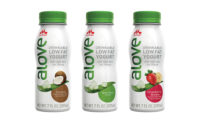While yogurt is certainly still having its day, other cultured dairy products are seeing renewed interest. Consumers’ desires for variety in flavor and texture, clean ingredients and nutrient-dense snacks (like more protein or probiotics) are shining a spotlight on yogurt, cottage cheese, cream cheese and sour cream-based dips.
Milk | Cheese | Cultured | Ice Cream | Butter | Non-dairy Beverages | Ingredients | Exports
The versatility of Greek yogurt and its high protein content has opened doors for innovation. Greek yogurt is used in dips, blended with cream cheeses and used as an ingredient in cooking/baking. The Greek yogurt influence also introduced consumers to the idea of more variety, in terms of flavor, texture and function, said Chicago-based Mintel in its 2016 Yogurt and Yogurt Drinks report.
Yogurt manufacturers continue to innovate and look to trends. The biggest areas to watch are flavors, use of whole milk and milk from grass-fed cows, and drinkable options. Flavor innovation is huge — consumers can find ethnic influences, savory and sweet combinations, dessert flavors and coffee-infused varieties. Chobani, Stonyfield, Dannon and Smari have introduced whole-milk yogurts.
“Fat is back and people are really recognizing the dairy trends…it’s not the bad guy it once was,” said Koel Thomae, co-founder of noosa yoghurt, Bellvue, Colo.
By the numbers
In the major global markets in 2015, yogurt captivated consumers to the tune of 16.3 million tons, an increase of 4% over 2014, according to Fona International, Geneva, Ill. But U.S. sales do show some of the interest is waning. Yogurt still dominated the cultured category with overall sales of $7.5 billion. And though dollar sales did improve 1.1%, unit sales decreased 2% to 5 billion, as reported by Information Resources Inc. (IRI), Chicago, for the 52 weeks ended Sept. 4, 2016.
Yogurt production had been steadily climbing over the last five years, increasing from 4.18 billion pounds in 2010 to 4.75 billion pounds in 2014. But 2015 showed a slight decline to 4.74 billion pounds, according to the U.S. Department of Agriculture’s National Agricultural Statistics Service.
But the yogurt category could have a new star. Drinkable yogurt sales are off the charts. In the shelf-stable yogurt/yogurt drink segment, dollar sales jumped 54.4% to $25.5 million, and unit sales increased 40.8% to 13 million, according to IRI. And though this segment is small by comparison, it’s promising and there is a lot of room to grow. (See the table on page 40.) The latest research from Mintel shows that sales of yogurt drinks have grown a healthy 62% from 2011-2016. And sales are expected to grow 11% in 2016, making this the second straight year of double-digit gains.
Beyond the cup
Many processors we spoke with believe more snacking and portable options will be an important growth opportunity for yogurt. Manufacturers have already created more drinkable varieties and new squeezable pouches, but there’s plenty of room for more.
“Yogurt drinks are becoming increasingly popular among U.S. consumers, and as adoption of the yogurt drinks segment grows, so too does innovation,” said Beth Bloom, senior analyst, U.S. Food & Drink at Mintel. “It’s one of the few food and drink spaces where launch activity sees brand new products outpacing simple variations on form.”
According to Fona International’s report, nearly 70% of North American consumers eat yogurt as a snack. But other eating occasions have potential to catch up. According to Mintel, yogurt is among America’s top five breakfast items with just under half (45%) of U.S. consumers purchasing yogurt at retail for breakfast. Ninety-three percent of yogurt/yogurt drink consumers eat it for breakfast.
Lala, a brand of Dallas-based Borden Dairy, diversified its drinkable yogurt smoothies line with several new functional formats this year. It added Healthies Curb, which combines yogurt with grains, proteins and fiber for what it calls a more satiating product; 100-calorie yogurt smoothies; and new flavor varieties to its non-Greek line, including cherry vanilla. The company also launched a line called Craveables that features dessert-style flavors, like lemon bar and vanilla cupcake. A 6.7-ounce serving has 17 to 18 grams of sugar, 140 calories and 5 grams of protein.
“Through our research, we’ve found that yogurt smoothies are especially on-trend with millennials, who are driving much of the growth in better-for-you snacking,” said Desiree Johnson, director of marketing, Lala Brands.
Chobani, Norwich, N.Y., delved into drinkable yogurts with its Drink line, available in four varieties, including strawberry banana, mixed berry and apple vegetable. Pomeroy, Ohio-based Snowville Creamery is introducing a drinkable yogurt in multiserve 64-ounce gable-top cartons by the end of this year. The Dannon Co., White Plains, N.Y., added Oikos nonfat yogurt drinks, sold in 7-ounce bottles. A serving contains 110 calories, 10 grams of protein and 11 grams of sugar. It’s sold in four flavors: strawberry, mixed berry, banana creme and vanilla.
Baltimore, Ore.-based B’more Organic, which makes grass-fed Icelandic skyr smoothies in 16-ounce bottles, rebranded late last year with a cleaner look and more varieties. The company just added a coconut variety that’s flavored with organic coconut cream. The skyr contains 16 grams of protein per 8-ounce serving.
Yoplait, a brand of General Mills, Minneapolis, which already makes Go-Gurt tubes for kids, launched Go Big — grip and rip, squeezable 4-ounce pouches of low-fat yogurt that come in an 8-pack. The pouches are being marketed to people of all ages. The packs are sold with four cherry and four peach & mango varieties; and four mixed berry and four strawberry varieties.
Drinkable kefirs are also on the rise. Maple Hill Creamery, Stuyvesant, N.Y., launched an organic, 100% grass-fed whole-milk kefir line that’s available in three varieties — strawberry, plain and vanilla. Carteret, N.J.-based Rye Fresh Inc. introduced Cupful grass-fed kefir last year. The non-GMO kefir is sold in 32-ounce bottles (for drinking) in five flavors and 5.3-ounce cups (for spooning) in five flavors. The drinkable flavors include vanilla, blueberry and strawberry.
Yogurt diversifies
Sales of Greek and specialty yogurt outperform regular dairy yogurt in natural food channels despite a slowdown in growth. Consumers remain engaged in the category, despite the array of competing options for breakfast, snacking and other occasions, Mintel noted. Continuing and boosting engagement sparked by the Greek yogurt boom will be key, along with offering more variety (styles and flavors) and function (convenient health and satiety).
“Full-fat varieties are seeing strong sales growth at natural channels, while nonfat options struggle, pointing to a growing acceptance of fat in food,” said Mintel’s Bloom.
Noosa yoghurt, which makes its Australian-style yogurt with whole milk, introduced several new flavors that tap into the savory trend, including Mexican chocolate, pineapple jalapeno, blood orange, salted caramel and key lime. The company also added more varieties in its 4-ounce 4-packs. Smari, Petaluma, Calif., which makes organic, grass-fed whole-milk Icelandic-style yogurt, added more flavors, including pineapple, black cherry and chia, and New Orleans coffee.
Trimona Bulgarian yogurt, owned by Trimona Foods Inc., Port Jefferson, N.Y., which originally just made plain yogurt, recently added four flavors, including honey ginger cinnamon and blueberry lavender. The unstrained Bulgarian yogurt is whole-fat, non-GMO, organic and grass-fed.
International-style yogurts aren’t the only ones getting the memo that full-fat is back.
Liberte USA, a brand of General Mills, launched an organic line that’s made with whole milk. Flavors include French lavender, Philippine coconut and Ecuadorian mango. Getting back to its roots, Stonyfield, Londonderry, N.H., introduced whole-milk Greek yogurt, 100% grass-fed whole-milk yogurt and whole-milk yogurt pouches. La Farge, Wis.-based Organic Valley added grassmilk yogurts to its line in 24-ounce containers and 6-ounce cups.
Dannon added new yogurts that feature more natural and non-GMO ingredients, including Dannon Whole Milk and a reformulated Oikos 0% line. The whole-milk line comes in eight flavors, including strawberry and peach, with ingredients that includes vitamin D. The Oikos line has six flavors, like strawberry, mixed berry and blueberry, and also contains vitamin D. The new recipe boasts 25% less sugar than before — a 5.3-ounce serving contains 14 grams of sugar and 12 grams of protein.
Yogurt can be sweet or savory
Savory and sweet flavor combinations were popping up across the yogurt category all year. Because of its simple, clean, slightly acidic base, yogurt plays well as both sweet and savory, said Fona International.
Mintel’s Bloom told Dairy Foods earlier this year, “Consumer palates appear to be expanding, moving into more complex flavor profiles like spicy and bitter. I think there’s some influence from international food trends introduced through foodservice.”
Chobani added a sriracha mango flavor in its Flip line. The yogurt features mango yogurt with sriracha-coated rice crisps, mini sesame sticks and roasted/salted cashew pieces. New York, N.Y.-based Blue Hill, which makes yogurt with milk from grass-fed cows, has vegetable-based flavors in six varieties, including carrot, beet, tomato, butternut squash and sweet potato.
But savory doesn’t claim the whole story. Dessert-style or indulgent flavors continue to grow. In its Flip line, Chobani added a peanut caramel variety (low-fat caramel Greek yogurt with roasted peanuts, milk chocolate and chewy caramel bits). In its Simply 100 line it added lemon meringue crisp (lemon nonfat Greek yogurt with citrus white chocolate and lemon cookies).
Dannon extended its Light & Fit portfolio with new Light & Fit Greek Crunch, featuring mix-ins. Flavors include Caramel Fudge Pretzel (salted caramel nonfat Greek yogurt with pieces of fudge covered pretzels) and Coconut Chocolate Bliss (toasted coconut nonfat Greek vanilla yogurt with graham cracker, dark chocolate and almond topping). The company also introduced Oikos Crunch Greek (also with mix-ins) in banana peanut butter crunch and other flavors.
Keeping up with yogurt
Manufacturers of cottage cheese, cream cheese and sour cream are rising to the challenge with flavor and packaging innovation. Companies are tapping into consumers’ desire for more high-quality protein and snack options. Peruse the cultured aisles and you’ll see unique flavors and smaller sizes of cottage cheese, interesting cream cheese flavor combos, and high-protein dips made with Greek yogurt, to name a few.
In the cottage cheese category, though dollar sales dropped 0.1% to $1.1 billion, unit sales increased 3.6% to 436.4 million, according to IRI.
Flavored cottage cheeses are trending. Manufacturers are getting creative with flavors, going to single-serve cup sizes and touting the high-protein content.
Los Angeles-based Good Culture, a flavored cottage cheese line that launched last year, updated its recipe and packaging this year. The non-GMO cottage cheese is now made with whole milk. The company also updated the container with a cleaner look and new shape. It’s available in five flavors, including its new pineapple flavor, sundried tomato, Kalamata olive and blueberry chia. A 5.3-ounce serving contains 18 grams of protein.
“Taste, nutrition, variety and portability. These have been elements of yogurt that fueled its growth but have been lacking in some manner in cottage cheese,” said Gerard Meyer, CEO of Muuna, Princeton, N.J.
Muuna said it aims to “reimagine” cottage cheese with its new line of flavored cottage cheeses. Packaged in unique, bright, single-serve cups, the cottage cheese is sold in six varieties: strawberry, blueberry, pineapple, peach, mango and low-fat plain. It contains 19 grams of protein per 5.3-ounce container.
Cream cheese, dips go savory
The cream cheese/cream cheese spread category showed dollar sales up 1.8% to $1.6 billion, with unit sales up 0.1% to 662.9 million, according to IRI. And sales were not so sour in the sour cream category — dollar sales rose 2.9% to $1.2 billion and unit sales increased 2.6% to 619.1 million.
Flavored cream cheeses are also trending as manufacturers look to interesting combinations like spices or fruit, said Aubrecia Houston, senior brand manager at Arla Foods, Basking Ridge, N.J. The company launched a line of flavored cream cheeses this year in five varieties, including herbs & spices, blueberry and peppercorn. Its cream cheese is made with no artificial flavors or preservatives (as stated on the packaging).
Fulfilling a demand for more contemporary flavors, La Terra Fina, Union City, Calif., introduced two new varieties of its cream cheese-based dips/spreads — spicy green chile & cheese and vanilla bean cheesecake. The spicy one is also made with Cheddar cheese. The company also has Greek yogurt-based dips, like spinach & kale, which is made with cream cheese and Parmesan cheese. This dip boasts 45% less fat and calories, with a two tablespoon serving containing 50 calories, 4 grams of fat and 3 grams of protein.
Chobani went beyond the yogurt aisle with its launch of Mezé Dips, a savory Greek yogurt-based product. The Mediterranean-inspired dips are available in four varieties, like roasted red pepper and three-pepper salsa. A one tablespoon serving contains 25 calories, 1 gram of fat and 3 grams of protein.
Evolving to cleaner ingredients
Some of the biggest news this year in the clean label department came from Dannon, which pledged in April to increase transparency for its portfolio of products. The company will evolve to using more natural (and fewer) ingredients and to use non-GMO ingredients in its flagship brands — Dannon, Oikos and Danimals. Additionally, all Dannon products in the United States that still have GMO ingredients will be clearly labeled.
Arla Foods takes clean labels to another level with its push for clear labels, which means “every ingredient in a product serves a purpose,” said Arla’s Houston. To explain that further, it means a manufacturer only uses ingredients that provide an essential function and are absolutely necessary. Arla’s original cream cheese is made with just four ingredients: milk, cream, cheese culture and salt.
Springfield, Mo.-based Hiland Dairy introduced an all-natural sour cream last year, which hit stores this year. The product has only three ingredients: Grade A cultured milk, cream and enzymes.
Packaging matters
In packaging news, the focus was on clean or more modern looks, and calling out ingredients (like high-protein or probiotics) or lack thereof (like no artificial sweeteners and non-GMO). Clear containers (another trend) serve a dual purpose — they go hand-in-hand with clean/transparency of a brand and it brings a premium look.
Coinciding with General Mills’ launch of Liberte Organic, the packaging was redesigned as well. It has a new shape, with a fully transparent cup to see the yogurt inside.
“The shape conveys a more unique and premium offering, along with the ingredients and flavors,” said representatives from the General Mills yogurt division.
Yoplait also recently updated its cup packaging. The new look is more modern and “better communicates to consumers [the] fresh, real, ingredients,” said General Mills.
Lala redesigned to call out the product name — “yogurt smoothie” — and focused on ingredients. Pictures of fruit take center stage on the packaging in bold colors. Call outs note the protein content and lack of artificial sweeteners or flavors.
In conclusion
There’s clearly a lot to talk about in cultured dairy as the category continues to innovate and follow trends. Cultured dairy has everything consumers are looking for today — protein, clean ingredients and variety. As Mintel noted, the category comes close to hitting the trifecta — it’s good-tasting, convenient and offers good-for-you options. But room for improvement still exists.
What’s the industry talking about?
- Whole-milk/full-fat
- Drinkable yogurts
- Savory flavors
- High protein
- Clean ingredients
- Grass-fed
- Non-GMO
- Probiotics
- Snacking
- Dessert flavors
Milk | Cheese | Cultured | Ice Cream | Butter | Non-dairy Beverages | Ingredients | Exports












